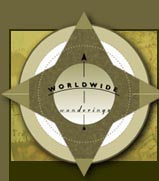|
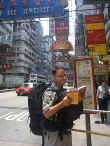 July 19-28, 1999 Hong Kong July 19-28, 1999 Hong Kong"Ya
know what? I like this place already." "But we've only been here for less than a
half hour." "Yeah, I know, but you know how we usually have a gut feel for how
much we're gonna like a place, even in the beginning? Well something about this one just
feels right to me, at least so far." It's at least 34 Celsius (about 93 Fahrenheit)
in the dead afternoon of a super-humid July day. We're tromping around Hong Kong's
bustling city streets, under the weight of our fairly hefty packs; getting dripped on from
the legions of A/C units, retrofitted into the hundreds of windows, rising stories and
stories above our heads; cringing with pain as squealing bus brakes, squeaking like a
giant's nails screeching across a chalk board, pierce the otherwise 'gray' noise of
engines and horns; and looking for a hotel that's doing it's best to stay hidden within
the massive trunks of this concrete jungle. Despite all this, Hong Kong still feels
right to me.
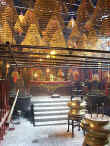 For starters, this lively city has more of a 'Chinese
feel' than I'd imagined. And that, in my opinion, is a good thing. Although influences
from the West (especially British), are a conspicuous part of the city, Hong Kong is still
first and foremost, a place for and of the Chinese people. Sadly, it's many of those
people (most notably those who spoke the best English) who thought it best to leave the
territory in 1997, just before it was turned back over to mainland control, rather than
face the uncertainties of Beijing rule. But the charms of this city must be hard to
substitute, because now, from what I've gathered by chatting with those who've stayed
through the transition, many of those who left are now returning. I can't say as I blame
them, it's an addicting place. For starters, this lively city has more of a 'Chinese
feel' than I'd imagined. And that, in my opinion, is a good thing. Although influences
from the West (especially British), are a conspicuous part of the city, Hong Kong is still
first and foremost, a place for and of the Chinese people. Sadly, it's many of those
people (most notably those who spoke the best English) who thought it best to leave the
territory in 1997, just before it was turned back over to mainland control, rather than
face the uncertainties of Beijing rule. But the charms of this city must be hard to
substitute, because now, from what I've gathered by chatting with those who've stayed
through the transition, many of those who left are now returning. I can't say as I blame
them, it's an addicting place.
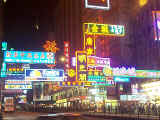 It's
about 10:00 p.m. as we meet up for a nightcap with Sean, an expat living in Hong Kong who
we met in Malaysia just two weeks ago. Our first stop is one of the city's oldest and most
famous watering holes, Felix, on the top floor of the grand Peninsula Hotel. Our view of
the harbor, resplendent with the neon signatures of capitalism, is almost as breath-taking
as the $32 bill for our three little cocktails. Ouch! Can I put 20% down and get that on a
30 year fixed on that? For something a little more down-to-earth (sea level in fact), we
take a $0.32 each Star Ferry ride across Victoria Harbor. After more that 100 years, it's
still one of the city's favorite and most reliable ways to cross the waterway. It's
about 10:00 p.m. as we meet up for a nightcap with Sean, an expat living in Hong Kong who
we met in Malaysia just two weeks ago. Our first stop is one of the city's oldest and most
famous watering holes, Felix, on the top floor of the grand Peninsula Hotel. Our view of
the harbor, resplendent with the neon signatures of capitalism, is almost as breath-taking
as the $32 bill for our three little cocktails. Ouch! Can I put 20% down and get that on a
30 year fixed on that? For something a little more down-to-earth (sea level in fact), we
take a $0.32 each Star Ferry ride across Victoria Harbor. After more that 100 years, it's
still one of the city's favorite and most reliable ways to cross the waterway.
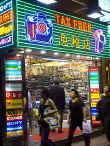 While Laura, Sean and I are becoming
entranced by the myriad of reflections dancing off of the waves, the small girl in front
of us seems more enthralled with a game of 'I write a character on your back with my
finger and you guess it' with her bigger brother. It's funny that it's the same game that
I used to play with my brother and sister when we were their age (except that we weren't
scripting out kanji symbols, of course). With a bump, our ferry docks on the island side.
Two attendants, dressed smartly in their powder blue sailor suits, use old frayed ropes,
straining over even older squeaky pulleys, to lower the gangway to the dock. Here we are
in a capital of high-tech automation, and they still raise and lower the plank manually.
Hum, whatever works, I think to myself. While Laura, Sean and I are becoming
entranced by the myriad of reflections dancing off of the waves, the small girl in front
of us seems more enthralled with a game of 'I write a character on your back with my
finger and you guess it' with her bigger brother. It's funny that it's the same game that
I used to play with my brother and sister when we were their age (except that we weren't
scripting out kanji symbols, of course). With a bump, our ferry docks on the island side.
Two attendants, dressed smartly in their powder blue sailor suits, use old frayed ropes,
straining over even older squeaky pulleys, to lower the gangway to the dock. Here we are
in a capital of high-tech automation, and they still raise and lower the plank manually.
Hum, whatever works, I think to myself.
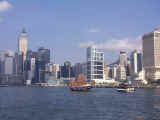 A quick taxi ride brings us to the top of Victoria Peak for a look
over the world's busiest harbor from this, its opposite side. The lights from some of the
earth's tallest buildings sparkle below us. Even though the S.A.R. (special administrative
region) of Hong Kong is actually made up of 260 mountainous islands, only a handful of
these are actually populated. And in reality, the concentration Hong Kong's humanity is
packed into the area spread out just before us, the land immediately surrounding the
harbor. Across the water, Kowloon, on the southern tip of the mainland peninsula, and on
our side, the Central district, on the northern side of Hong Kong Island itself. A quick taxi ride brings us to the top of Victoria Peak for a look
over the world's busiest harbor from this, its opposite side. The lights from some of the
earth's tallest buildings sparkle below us. Even though the S.A.R. (special administrative
region) of Hong Kong is actually made up of 260 mountainous islands, only a handful of
these are actually populated. And in reality, the concentration Hong Kong's humanity is
packed into the area spread out just before us, the land immediately surrounding the
harbor. Across the water, Kowloon, on the southern tip of the mainland peninsula, and on
our side, the Central district, on the northern side of Hong Kong Island itself.
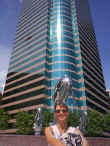 Predictably,
this cram-jam has resulted in some of the world's highest real estate prices (a
one-bedroom around the peak starts at over $6,500/month). Understandably, most developers
have been forced to build up instead of out. Towers stack against more towers in this
'vertical city', culminating in a modern, vibrant metropolis that likes to call itself 'a
small place that lives large'. A small place is right. All those islands, and the majority
of Hong Kongers just have to all pack themselves onto this one. 'Let's stack on top of
each other', seems the prevailing attitude. Hey, whatever works. Predictably,
this cram-jam has resulted in some of the world's highest real estate prices (a
one-bedroom around the peak starts at over $6,500/month). Understandably, most developers
have been forced to build up instead of out. Towers stack against more towers in this
'vertical city', culminating in a modern, vibrant metropolis that likes to call itself 'a
small place that lives large'. A small place is right. All those islands, and the majority
of Hong Kongers just have to all pack themselves onto this one. 'Let's stack on top of
each other', seems the prevailing attitude. Hey, whatever works.
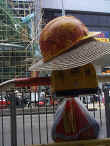 The
next morning brings us out and about with plans to explore as much of the city as we can
on foot. We immediately slide right into the pulse of the streets. We slip into the
city's energy, its activity, its hustle and its bustle. Everywhere around us, things seem
in constant motion. Being either built, rebuilt, razed for new construction, or repaired.
That buzz of activity, mixed with all the other sounds and smells, combine to lend a
distinct and noticeable 'makin' it happen' air to this spirited city. Dubbed by many as
the Manhattan of the East, Hong Kong does, at least on the surface, share much with its US
counterpart. The
next morning brings us out and about with plans to explore as much of the city as we can
on foot. We immediately slide right into the pulse of the streets. We slip into the
city's energy, its activity, its hustle and its bustle. Everywhere around us, things seem
in constant motion. Being either built, rebuilt, razed for new construction, or repaired.
That buzz of activity, mixed with all the other sounds and smells, combine to lend a
distinct and noticeable 'makin' it happen' air to this spirited city. Dubbed by many as
the Manhattan of the East, Hong Kong does, at least on the surface, share much with its US
counterpart.
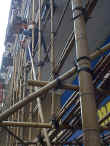 Yet a closer look reveals that for each similarity, there are at
least as many contrasts. For example, although both are filled with skyscrapers, those in
NYC are usually named after companies, or sometimes people. While those in Hong Kong are
graced with loftier notions of well wishing such as 'Good Results', Prosperity', or 'Best
Luck'. And while the gravity defying monstrosities of chrome and glass in NYC are
constructed with cranes, those in Hong Kong are pieced together by workers on bamboo
scaffolding. That's right bamboo. Imagine yourself with a toolbelt and hardhat,
clamoring around on sticks strapped together with string, climbing as high as 60 stories.
Not me! But I can't argue with whatever works here, I suppose. Yet a closer look reveals that for each similarity, there are at
least as many contrasts. For example, although both are filled with skyscrapers, those in
NYC are usually named after companies, or sometimes people. While those in Hong Kong are
graced with loftier notions of well wishing such as 'Good Results', Prosperity', or 'Best
Luck'. And while the gravity defying monstrosities of chrome and glass in NYC are
constructed with cranes, those in Hong Kong are pieced together by workers on bamboo
scaffolding. That's right bamboo. Imagine yourself with a toolbelt and hardhat,
clamoring around on sticks strapped together with string, climbing as high as 60 stories.
Not me! But I can't argue with whatever works here, I suppose.
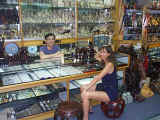 Also
like NYC, advertising images abound. While most of the 'special offer' or sale text around
us is in kanji symbols, the international brand names are still in those oh so familiar
alpha characters - Gorgio Armani, DKNY, Versacci, Calvin Klein, Izod, Esprit, Ralph
Lauren, Guess, and Louis Vuitton. Rolex, Tag Heuler, and Longines. The list goes on. Yep,
the ad images are everywhere. Hundreds of them hit us with each glance, in this, the
undisputed shopping capital of the world. SHOPPING, SHOPPING, SHOPPING - from marble
floored malls, to tarp covered stalls. Yes, even in dark alley calls: "Copy watch,
copy watch. Rolex. Hey Mister, copy watch, you like Rolex?" Bargains upon bargains
just waiting to be discovered - from markdowns on marital aids to discounts on divine
deities. Anything and everything you could ever want, or even imagine wanting, is
available (and probably on sale) here in Hong Kong. And all tax free! It's truly raw
unfettered capitalism, with few rules and at its very best. Also
like NYC, advertising images abound. While most of the 'special offer' or sale text around
us is in kanji symbols, the international brand names are still in those oh so familiar
alpha characters - Gorgio Armani, DKNY, Versacci, Calvin Klein, Izod, Esprit, Ralph
Lauren, Guess, and Louis Vuitton. Rolex, Tag Heuler, and Longines. The list goes on. Yep,
the ad images are everywhere. Hundreds of them hit us with each glance, in this, the
undisputed shopping capital of the world. SHOPPING, SHOPPING, SHOPPING - from marble
floored malls, to tarp covered stalls. Yes, even in dark alley calls: "Copy watch,
copy watch. Rolex. Hey Mister, copy watch, you like Rolex?" Bargains upon bargains
just waiting to be discovered - from markdowns on marital aids to discounts on divine
deities. Anything and everything you could ever want, or even imagine wanting, is
available (and probably on sale) here in Hong Kong. And all tax free! It's truly raw
unfettered capitalism, with few rules and at its very best.
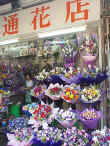 Few rules, but two certain laws: supply and demand and survival of
the fittest. These reign supreme, as rows and rows of stalls, selling essentially the same
goods, cluster together in markets around the city. There are morning markets, night
markets, even specialty markets. Flowers, goldfish, women's clothing, even songbird
markets. Tweet, twirp, cheep, and chirp. We're suddenly surrounded by hundreds of little
feathered friends, each perched in a hand-made rattan cage. Twirll, tweea-eep, swiwirl,
and sha-weep. "My bet is that they're complaining about the heat." I suggest to
Laura. "Look, it's so hot that they're sitting there with their tiny breaks hanging
open - like dogs do when they pant." "Or maybe they're just hungry, and waiting
for those things." Laura says as she points to a woman carefully chopping the legs
off of a bag full of live grasshoppers, in diligent preparation of feeding time. Few rules, but two certain laws: supply and demand and survival of
the fittest. These reign supreme, as rows and rows of stalls, selling essentially the same
goods, cluster together in markets around the city. There are morning markets, night
markets, even specialty markets. Flowers, goldfish, women's clothing, even songbird
markets. Tweet, twirp, cheep, and chirp. We're suddenly surrounded by hundreds of little
feathered friends, each perched in a hand-made rattan cage. Twirll, tweea-eep, swiwirl,
and sha-weep. "My bet is that they're complaining about the heat." I suggest to
Laura. "Look, it's so hot that they're sitting there with their tiny breaks hanging
open - like dogs do when they pant." "Or maybe they're just hungry, and waiting
for those things." Laura says as she points to a woman carefully chopping the legs
off of a bag full of live grasshoppers, in diligent preparation of feeding time.
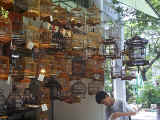 Then over here, there's a few chirpers enjoying a refreshing shower
from a boy with a squirt bottle. The birds seem thrilled with this, as they flap and
flitter under the spray's cool drops. Everyone seems to be enjoying these daily rituals
now, but two years ago, the new Beijing government was planning on closing this market.
Fortunately, they came to understand that the outlet provides a pleasant, established
venue where Hong Kongers can not only conduct business, but also peruse the relaxing
pastime of raising these melodious songbirds. 'Whatever works' the government must've
shrugged when it made the wise decision to keep open, and even improve, the famous Yuen Po
Street Bird Garden. Then over here, there's a few chirpers enjoying a refreshing shower
from a boy with a squirt bottle. The birds seem thrilled with this, as they flap and
flitter under the spray's cool drops. Everyone seems to be enjoying these daily rituals
now, but two years ago, the new Beijing government was planning on closing this market.
Fortunately, they came to understand that the outlet provides a pleasant, established
venue where Hong Kongers can not only conduct business, but also peruse the relaxing
pastime of raising these melodious songbirds. 'Whatever works' the government must've
shrugged when it made the wise decision to keep open, and even improve, the famous Yuen Po
Street Bird Garden.
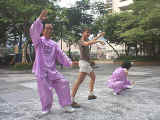 We're up and at 'em early the next morning to start our day with
the ancient Chinese exercise known as Tai Chi. After an hour or so of clumsily trying to
mimic our skilled (and patient) instructors, we discover firsthand that this slow-motion
form of marshal art is much more difficult and demanding than it looks. "Practice of
Tai Chi" our instructors assure us "is very good for you." Apparently so,
for it seems that this early morning routine is one of the most popular methods Hong
Kongers have of dealing with the stress and stain that accompanies living in such a
crowded city. We're up and at 'em early the next morning to start our day with
the ancient Chinese exercise known as Tai Chi. After an hour or so of clumsily trying to
mimic our skilled (and patient) instructors, we discover firsthand that this slow-motion
form of marshal art is much more difficult and demanding than it looks. "Practice of
Tai Chi" our instructors assure us "is very good for you." Apparently so,
for it seems that this early morning routine is one of the most popular methods Hong
Kongers have of dealing with the stress and stain that accompanies living in such a
crowded city.
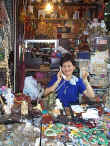 Other
the next few days, we try other ways too. Including simple things such as casual, friendly
human interaction. For instance, a quick wave to the manager at our favorite rice and
noodles diner on the corner, or a quick 'layho' (Cantonese for hello) as we pass by the
cashier at the newsstand that we pop into each night for a bottle of water. These both do
wonders to raise our tolerance of the noise and commotion around us. We also try another
popular therapy known as reflexology. A method of massage the concentrates on certain
pressure points, it's painful, healing, and relaxing all at the same time. Other remedies
in favor with the city's residents include traditional medicines and foods, such as ox
tongue, shark fin, snake skin, deer antler, or dried seahorse. We decided to pass on
these, but hey, whatever works for them. Other
the next few days, we try other ways too. Including simple things such as casual, friendly
human interaction. For instance, a quick wave to the manager at our favorite rice and
noodles diner on the corner, or a quick 'layho' (Cantonese for hello) as we pass by the
cashier at the newsstand that we pop into each night for a bottle of water. These both do
wonders to raise our tolerance of the noise and commotion around us. We also try another
popular therapy known as reflexology. A method of massage the concentrates on certain
pressure points, it's painful, healing, and relaxing all at the same time. Other remedies
in favor with the city's residents include traditional medicines and foods, such as ox
tongue, shark fin, snake skin, deer antler, or dried seahorse. We decided to pass on
these, but hey, whatever works for them.
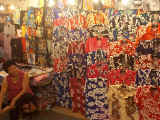 It's our last night in Hong Kong and we've decided that
the best place to spend it is in the colorful and chaotic Temple Street night market.
We've wandered into its heart of it, the market's food stalls, for a bite to eat.
"They're laughing at you." "Who?" "The couple at the next table.
They were watching you with the soy sauce and then broke out in giggles. You must not be
doing something right." It's our last night in Hong Kong and we've decided that
the best place to spend it is in the colorful and chaotic Temple Street night market.
We've wandered into its heart of it, the market's food stalls, for a bite to eat.
"They're laughing at you." "Who?" "The couple at the next table.
They were watching you with the soy sauce and then broke out in giggles. You must not be
doing something right."
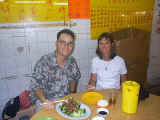 "Excuse
me, try this way" one of the hawkers/waiters offers, as he demonstrates how to use
the deep porcelain spoon to scoop out only a few drops of the sauce and add it delicately
to a three or four grains of rice in my bowl. This as opposed to my ad hoc, and obviously
incorrect, method of practically drowning the rice with the soy, by pouring in almost the
entire container's worth straight from the bowl? "Maybe you like this, maybe not.
What ever best for you, what ever work" he says. Yeah, I think to myself, that's Hong
Kong, the land of 'whatever works'. "Excuse
me, try this way" one of the hawkers/waiters offers, as he demonstrates how to use
the deep porcelain spoon to scoop out only a few drops of the sauce and add it delicately
to a three or four grains of rice in my bowl. This as opposed to my ad hoc, and obviously
incorrect, method of practically drowning the rice with the soy, by pouring in almost the
entire container's worth straight from the bowl? "Maybe you like this, maybe not.
What ever best for you, what ever work" he says. Yeah, I think to myself, that's Hong
Kong, the land of 'whatever works'.
|
